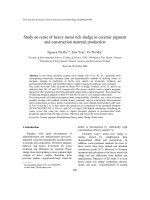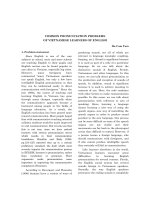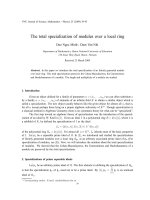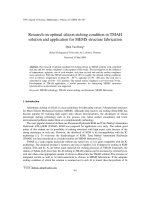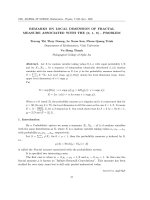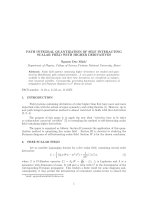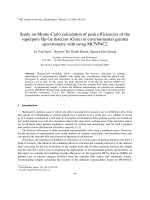Tài liệu Báo cáo " Study on reuse of heavy metal rich sludge in ceramic pigment and construction material production " docx
Bạn đang xem bản rút gọn của tài liệu. Xem và tải ngay bản đầy đủ của tài liệu tại đây (158.25 KB, 7 trang )
VNU Journal of Science, Natural Sciences and Technology 24 (2008) 280-286
280
Study on reuse of heavy metal rich sludge in ceramic pigment
and construction material production
Nguyen Thi Ha
1,
*, Tran Yem
1
, Vu Thi Mai
2
1
Faculty of Environmental Science, College of Science, VNU, 334 Nguyen Trai, Hanoi, Vietnam
2
Department of Environment, Natural resource and Environment College
Received 29 October 2008
Abstract. In this study, primarily treating waste sludge rich of Cr, Ni, Fe,…generated from
electroplating wastewater treatment plant and experimentally methods of utilizing wastes as
inorganic pigment in production of bricks were carried out. Economic, technical and
environmental efficiency and feasibility, bases to apply to practical conditions were evaluated.
The results show that water accounts for about 70% of sludge. Contents of Ni, Cr and Fe are
relatively high (20, 4.5 and 2.5%, respectively). The wastes could be used to replace inorganic
pigment in brick production after being primarily treated with a simple procedure. The optimal rate
of replacing inorganic pigment is about 5% and 20% in case of raw material replacement.
The testing results of technical parameters about compressibility, flexibility, size…show all tested
products meeting with standard of brick brands commonly used in construction. Environmental
safety testing based on heavy metals concentration in rain water soaking tested products (pH value
of 5.6-5.9) during 2 to 21 days shows the satisfactory in comparison to the permitted standards
(TCVN 5945-2005: Fe< 5, Ni< 0.5, and Cr
6+
< 0.1mg/l). Cost-benefit calculations of utilizing the
wastes reveal that using the wastes to replace inorganic pigment in pavement-tiled brick
production gained relatively high economic efficiency and ensure the environmental safety.
Keywords: Ceramic pigment; Electroplating; Heavy metal; Sludge; Waste reuse.
1. Introduction
∗
∗∗
∗
Together with rapid development of
industrialization and modernization processes,
industrial waste has dramatically increased both
in amount and composition. Therefore adequate
behavior and proper investment for waste
treatment and utilization are required. Waste
sludge from electroplating system contains high
content of heavy metals. Resulting from
previous studies, organisms/livings could be
_______
∗
Corresponding author. Tel.: 84-4-38584995.
E-mail:
killed or decomposed by sufficiently high
concentration of heavy metal [1-3].
Currently, heavy metal rich sludge is
mainly treated by solidification then
disposed/land filled and incineration. In
addition, some treatment methods for reuse of
these wastes have been studied and obtained
satisfactory results [3-7]. However, in Vietnam
treatment and utilization of the heavy metal rich
sludge has not sufficiently been studied and
implemented. Objective of the study is to treat
heavy metal rich sludge (containing chrome,
nickel, and iron); reuse/utilization of treated
N.T. Ha et al. / VNU Journal of Science, Natural Sciences and Technology 24 (2008) 280-286
281
sludge for replaced material as color blending
(pigment) and raw material in flower brick and
cement brick production.
2. Experimental Method
2.1. Heavy metal rich sludge: The heavy
metal rich sludge discharged from the
electroplating waste water treatment system in
Goshi-ThangLong enterprise is about 1 ton of
wet sludge per day.
2.2. Sludge treatment: Thickened sludge
was taken and treated (see figure 1) and utilized
as construction material (partly replaced raw
material and color powder). Experiments were
implemented in 27-7 Brick company in Thanh
Son village, Kim Bang district, Ha Nam
province.
\
Fig. 1. Diagram of thickened sludge treatment.
2.3. Treated sludge re-usage: The
experiments were carried out to reuse treated
sludge as: (1) alternative partly raw material;
and (2) pigment for some color and flowered
bricks/enameled tiles. For the first
investigation, treated sludge partly replaced raw
material based on the ratio of cement and raw
additive of 1: 3 (the weight of a brick is ~1.7-
2.0kg). The ratio of treated sludge and raw
material varied as 1:1; 1:3; 1:5; and 1:10. In the
latest, treated sludge was mixed with red
pigment and cement (white and black cement) a
the ratio of 1:1:1.
2.4. Product test for technical parameters
and environmental safety: The technical
parameters including compressibility;
erasability, curvature and water absorption were
analyzed/tested in the laboratory of
Construction material, Hanoi University of
Construction. The environmental safety of
sludge re-usage was assessed based on heavy
metals leaching after 2, 14 and 21 days of
soaking in rain water. The experiments were
carried out in the laboratory of Environmental
analysis, faculty of Environmental Sciences and
department of Environmental analysis, Institute
of Environmental Technology.
Heavy metal rich sludge
Dehydration
(dry at room temperature and at 105
0
C-110
0
C)
Fine screening (d ≤ 0,05 mm)
Reuse
Cooling
Treating and Grinding
N.T. Ha et al. / VNU Journal of Science, Natural Sciences and Technology 24 (2008) 280-286
282
3. Results and discussion
3.1. Analysis result of heavy metal rich sludge
composition
Analysis result of chemical compositions of
heavy metal sludge showed that the sludge
taken from Goshi -Thanh Long company
contains some heavy metals like Cr, Ni, Fe with
very high content, especially nickel (up to
20%). The sludge contains about 70-75% of
water (table 1).
Table 1. The main compositions of sludge
Sample Component (%)
S1 S2 S3
Nickel (Ni) 20 19.6 21,4
Chrome (Cr) 4.15 4.54 4.32
Iron (Fe) 2.07 2.42 2.52
Water (H
2
O) 75 71 70
Sludge samples S1; S2; S3 were taken in October,
November and December 2007
In addition, the content of heavy metals and
water of sludge samples taken in 3 surveys
were relatively consistent.
3.2. Reuse of treated sludge in brick production
Treated sludge was used as partly
alternative raw material and pigment of
flowered bricks/enameled tiles. The replaced
ratio for raw material varied as 1:1; 1:3; 1:5;
and 1:10. The treated sludge was used as
pigment when mixed with red pigment and
cement (white and black cement) at the ratio of
1:1:1 (see table 2).
The weight of a cement brick is about 3kg
of which the ratio of cement and raw material
of 1:2. Cement brick produced with high ratio
of treated sludge partly replaced raw material
having fine surface but more sticky and more
difficulty when demolishing (table 3).
Table 2. The results of the experiment in Flower brick production
Material ratio* Altered material used for Quality of tested products
1: 1
Cracked surface
1: 3
1: 5
1: 10
Treated sludge: raw material
1: 15
Main part of the bricks (sole)
Fine surface
Treated sludge: white cement:
red powder
1: 1: 1
Cover (surface) part Fine pink color
* Number of trials is 4
Resulting from the experiments, the treated
sludge and raw material ratio of 1:1 is not
appropriate for both flower and cement brick
production. The tested products showed that
some cracked in surface or/and at the brick's
edges. The lower ratio of sludge in the mixture,
however, is suitable and good enough as altered
material. The products have fine color and are
in good quality that meet with the requirement
in term of surface/cover of brick and the
solidarity.
Table 3. The results of the experiment in Cement brick production
Material ratio* Altered material used for Quality of tested products
1: 1 Cracked surface (in corner of bricks)
1: 3
1: 10
Treated sludge: raw material
1: 15
Main part of the bricks (sole)
Good (fine surface)
Treated sludge: Black cement
1:1 Fine grey color
Treated sludge: White cement
1:1
Cover (surface) part
Fine white color
Note:* Number of replicated experiments. In each experiment number of tested product varied from 4 to 5.
N.T. Ha et al. / VNU Journal of Science, Natural Sciences and Technology 24 (2008) 280-286
283
In addition, for cement bricks the mixture of
sludge and white cement has brighter color in
compared with black cement. However the cost
should be taken into account because the price
of white and black cement is approximate
120,000 and 50,000VND/m
3
, respectively.
The sludge and raw material ratio of 1:10 or
1:15 should produce good quality bricks. These
low ratios, however, are not an effective
application due to very small amount of sludge
utilized whereas very large amount of sludge
daily discharged. This therefore does not meet
with the requirement in term of environment
and waste treatment/reuse. Higher ratios (1:3 or
1:5) are strongly recommended for practice. For
the ratio of 1:3, the quantity of sludge altered
accounts for 18-20% total mass of the brick
which is similar to the recommendation of
previous studies (altered material should be less
than 25% total mass) [7].
The mixture of sludge, white cement, and
red powder (ratio of 1:1:1) is appropriately used
as color powder for surface of flower brick. The
experiment was only carried out with this ratio
that referred from the previous studies [1,3].
3.3. Product testing for technical parameters
and environmental safety
The technical assessment is based on the
Vietnam standard for brick quality (TCVN
1451:1998). The testing result showed that
tested products not only meet with Vietnam
standard, but also is sometimes higher or better
quality in comparison with origin ones.
Table 4. Results in technical parameter testing of tested bricks
The ratio
Product
Origin
brick
Sludge: raw
material 1: 3
Sludge: raw
material 1: 10
Sludge: raw
material 1: 14
Sludge: White cement:
Red powder 1:1:1
Flower brick U 6.2 U 7.9 U 7.42 U 6.5
Cement brick
(block)
M 250 M 250 M 300 M 350
The quality of tested products were assessed
more adequately in term of environmental and
technical aspects. The results were based on the
concentration of some heavy metals existing in
sludge in the rain water soaked with bricks and
on some technical parameters (erasable,
curvature and water absorption).
As can be seen in figure 2 and 3, the
concentration of Cr, Fe and Ni in rain water
soaked with tested bricks is lower than
Vietnamese standard TCVN 5945-2005 (0.05; 5
and 1mg/l for Cr, Fe and Ni, respectively). The
higher content is obtained in the rain water
soaked by higher ratio of sludge in the material
mixture.
The concentration of Cr, Ni and Fe in water
increased with the soaking time, particularly
after 2days. From day 14 to 21 the increase
seems to be slight in comparison with the
beginning days.
N.T. Ha et al. / VNU Journal of Science, Natural Sciences and Technology 24 (2008) 280-286
284
Fig. 2. Concentration of some heavy metals existing
in sludge in the rain water soaking with bricks:
a) Cr b) Ni c) Fe
Flower brick:
M1 – Sludge: RM=1:3 M2 – Sludge: RM=1:15
M3 – Sludge: WC:RP=1:1:1 Cement brick:
M4 – Sludge: RM=1:3
M5 – Sludge: RM=1:15
M6 – Sludge: WC=1:1
The pH values of brick soaked water vary in
the range of 5.6 -6.9 and slightly increase with
the soaking time. The pH value of all effluents
meets with the Vietnamese standard (TCVN
5945-2005, category B). The findings are in
accordance with results of the other studies [3-7]
(figure 3).
Fig. 3. The variation of pH value of rain water
brick soaking.
3.4. Cost estimation
The results reveal that the optimal sludge
replaced up to 20% of total mass for brick’s
sole and 5-7% for surface (as pigment) is
recommended. The estimated cost and benefit
analysis will be based on these ratios with the
current amount of cement used (table 5).
As can be seen in the table 5, the benefit is
remarkable for the solution of replace 50% of
color powder by treated sludge (around 20
million VND per 100,000 bricks - monthly
production rate). However for the first option
(treated sludge altered raw material) lower
economic benefit but more effective and
valuable in waste management found because
much more amount of used sludge.
0
2
4
6
8
0 5 10 15 20
Soaking time (day)
pH Value
0
0,02
0,04
0,06
0,08
0,1
0 2 14 21
Soaking time
(day)
Concentration (mg/l)
0
0.05
0.1
0.15
0.2
0.25
0.3
0 2 14 21
Soaking time
(day)
Concentration (mg/l)
M1
M2
M3
M4
M5
M6
0
0,02
0,04
0,06
0 2 14 21
Soaking time
(day)
Concentration (mg/l)
N.T. Ha et al. / VNU Journal of Science, Natural Sciences and Technology 24 (2008) 280-286
285
Table 5. Estimated cost and benefit analysis for solutions of sludge reuse
Product
The ratio
origin
material
(%)
The ratio
of treated
sludge
(%)
Quantity of
raw material and
sludge*
Cost for raw material
Cost for sludge
Total cost
(VND)
Benefit
(balance)
(VND)
75 0
100 000 bricks x
2kg/brick x 0.75
= 150 ton
150 ton
x 90 000 VND/ton
= 13 500 000 VND
0 13 500000
Flower brick (sole
replaced)
56.25 18.75
100 000 bricks x
2kg/brick x
0.5625=112.5 ton (RM)
100 000 bricks x
2kg/brick x
0.1875=37.5 ton (S)
112.5 ton
x 90 000 VND/ton
= 10 125 000 VND
37.5 ton x
270 000 VND/ton
=1 875 000 VND
12 000000
1 500 000
2.5 0
100 000 bricks x
2kg/brick x 0.025=5 ton
5 ton x10 000 000
VND/ton= 50 000
000 VND
0 50 000000
Flower brick (surface
replaced)
1.25 1.25
100 000 bricks x
2kg/brick x0.0125=2.5
ton (RM)
100 000 bricks x 2
kg/brick x0.0125=2.5
ton (S)
2,5 ton x10 000 000
VND/ton
=25 000 000 VND
2,5 ton x
2000000
VND/ton
=5000000 VND
30 000000
20 000 000
Note: (*) The input quantity required to produce 100 000 bricks/month; Average weight of a brick is 2kg. RM – Raw
material; S- treated sludge
4. Conclusion and Recommendation
Followings are result from the study:
- The waste sludge from electroplating
wastewater treatment contains very high
percentages of heavy metals (Ni: 20; Cr: 4.5
and Fe 2.5%) .
- After treatment, the sludge can be
effectively reused as pigment for flower brick
(surface), the optimal ratio of 5% is
recommended and replaced raw material in
flower and cement brick production with up to
20% total mass per product.
- The testing in term of environmental
safety and technical parameters shows the
feasibility of the utilized solution. Technical
aspects meet the Construction standard when no
risks for environment (heavy metal leaching
into rain water) were found.
In further study, heavy metal leaching into
rain water with lower pH value and longer
soaking time should be investigated; the use of
mixing treated sludge with raw material/powder
for making some other brick products (fired
brick and ceramic) for optimizing product
quality concerning to both environmental and
technical aspects still be also the objective of
the following steps.
Acknowledgement
Financial support (Environmental
Protection Task: Code QMT-07-01) from
Vietnam National University, Hanoi and
Ministry of Natural Resource and Environment,
is very much appreciated. The authors would
like to acknowledge responsible persons from
Goshi-Thang Long company for their helpful
support to this work.
N.T. Ha et al. / VNU Journal of Science, Natural Sciences and Technology 24 (2008) 280-286
286
References
[1] Nguyen Thi Ha, Le Thuy Duong, Nguyen Thi
Phuong Thao, Study on treatment of waste
solution from nickel and chrome electroplate
coat scraping off process, Journal of Applied
Chemistry. 55 (2006), Iss. 7, 25. (in
Vietnamese).
[2] K. Minocha, Neeraj Jain, C. L. Verma. Effect of
inorganic materials on the solidification of heavy
metal sludge, Journal of Cement & Concrete
Research, 33 (2003) Iss. 10, 1695.
[3] Vu Thi Mai, Application of Waste auditing in
Electroplating workshop, Goshi-Thang Long
enterprise, Bachelor Final Thesis, Faculty of
Environmental Sciences, Hanoi University of
Science. 2003 (in Vietnamese).
[4] Tran Duc Trung, Study on the effect of rice husk
and ultra-glutinous additives on quality of
cement and mortar, Construction University.
2003 (in Vietnamese).
[5] Cristian Favoni, Dino Minichelli, Franco
Tubaro, Sergio Brückner, Alessandro
Bachiorrini and Stefano Maschio, Ceramic
processing of municipal sewage sludge (MSS)
and steel works slags (SS), Ceramics
International, In Press, Corrected Proof
(available online, 2004).
[6] Gordon, C. C. Yang, Durability study of a
solidified mercury- containing sludge, Journal of
Hazardous Materials, 34 (1993), Iss. 2, 217.
[7] I. Mohair, J. J. Szepvoigyi. Treatment of
particulate metallurgical wastes in thermal
plasmas, Journal of Chemical Engineering and
Processing, 44 (2005), Iss. 2, 225.
Nghiên cứu tái sử dụng bùn thải giàu kim loại nặng trong
sản xuất vật liệu xây dựng
Nguyễn Thị Hà
1
, Trần Yêm
1
, Vũ Thị Mai
2
1
Khoa Môi trường, Trường ðại học Khoa học Tự nhiên, ðHQGHN, 334 Nguyễn Trãi, Hà Nội, Việt Nam
2
Bộ môn Môi Trường, Trường Cao ñẳng Tài nguyên và Môi trường
Trong công trình này ñã xử lý sơ bộ bã thải rắn giàu kim loại nặng Cr, Ni, Fe…từ qui trình xử lý
nước thải của dây chuyền mạ và thử nghiệm giải pháp tận dụng bã thải làm bột màu vô cơ trong sản
xuất gạch lát vỉa hè, gạch lát nền. Tính khả thi về kinh tế, kỹ thuật và môi trường cũng ñã ñược ñánh
giá cụ thể ñể làm cơ sở triển khai áp dụng trong thực tế.
Kết quả cho thấy bã thải chứa 70% nước; hàm lượng niken, crom và sắt tương ứng 20; 4,5 và
2,5%. Bùn thải sau khi ñược xử lý sơ bộ với qui trình ñơn giản, chi phí thấp ñược tận dụng thay thế
một phần bột màu vô cơ cho sản xuất gạch (lát nền và gạch lát vỉa hè). Tỉ lệ thay thế bột màu tối ưu
khoảng 5%, thay thế nguyên liệu thô là 20%.
Kiểm tra các thông số kĩ thuật của sản phẩm gạch cho thấy yêu cầu về ñộ nén, ñộ uốn, ñộ cong
vênh, kích thước ñều ñáp ứng tiêu chuẩn của các Mac gạch sử dụng phổ biến trong xây dựng. Tính
an toàn về môi trường ñược ñánh giá qua nồng ñộ Ni, Cr, và Fe trong nước mưa sau khi ngâm sản
phẩm trong 2 - 21 ngày (pH của nước mưa ngâm biến thiên trong khoảng 5,6-6,9). Kết quả cho thấy
nồng ñộ kim loại trong nước ngâm ñều dưới mức TCVN 5945-2005: Ni<0,5; Cr
6+
<0,1 và Fe<5mg/l.
Tính toán chi phí lợi ích thấy rằng giải pháp tận dụng bã thải thay thế bột màu vô cơ trong sản xuất
gạch lát vỉa hè cho hiệu quả kinh tế khá cao và ñảm bảo an toàn về môi trường.
Từ khoá: Bột màu gốm; Mạ ñiện; Kim loại nặng; Bùn; Tái sử dụng chất thải.
